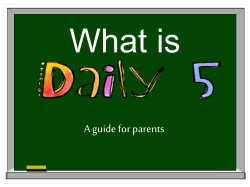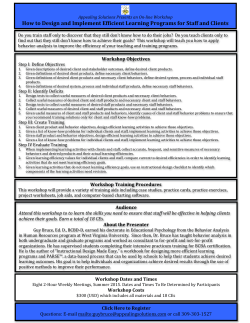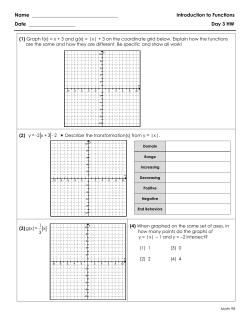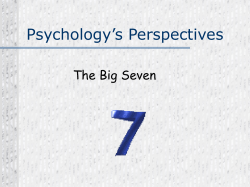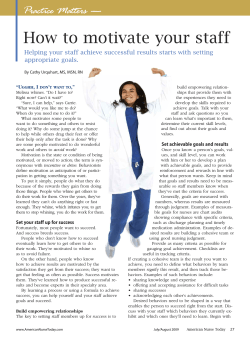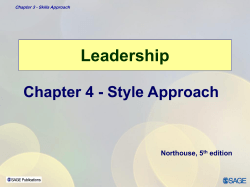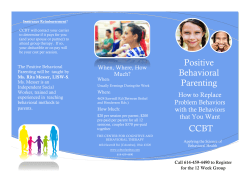
Cristi Wightman School Counselor Olathe District Schools
Cristi Wightman School Counselor Olathe District Schools Something to Think About… It’s a mystery… or is it? How did you know what to do when you walked into the classroom today? How did you decide where to sit? What would you have done if I had run in the room and screamed and ran out? What would you have thought if I had hugged all of you as you came in the door? What would you have thought it I had ignored all of you and sat looking at my notes? Did you think about how to create rapport with me? What is Social/Emo=onal Intelligence? Let’s take a closer look… Social awareness: being able to quickly sense their own and others’ inner state and understanding feelings and thoughts Social cognition: understanding the “unwritten rules” in almost any social situation Social facility: social awareness that helps create smooth, effective interactions “People who make an excellent social impression are adept at monitoring their own expression of emotion, are keenly attuned to the ways others are reacting, and are able to continually fine-‐tune their social performance to match the situation.” –Daniel Goleman The Big Challenge APPLICATION! To succeed in the social world, our kids need to not only understand how to “read” people and social situations, but also how to match and respond to them accurately and effectively. Some kids can “read” these, but they do not have the necessary skills to respond appropriately. They need to work on learning the ability to recognize feelings in themselves and others to be able to make smooth and rapid connections with others! 4 Components of interpersonal intelligence Organizing groups Negotiating solutions Personal connection Social analysis The price of smudged social lenses About 1 in 10 children suffer from emotional illiteracy or incompetence. This could be considered a behavioral learning disability in educational terms. 85% of these children have failed to learn to read and respond to non-‐verbal signals either because they haven’t interacted with peers much or their family didn’t display, communicate, or teach a given range of emotions or followed eccentric social norms. “Children who haven’t mastered the silent language of emotion and can’t read or express emotions well constantly feel frustrated and can’t figure out why others respond negatively to them. It leaves them feeling powerless and apathetic. This can interfere with their ability to learn effectively.” –Daniel Goleman Why is that kid so weird? A child with Dyssemia may not make eye contact, stand too close to others, have facial expressions inappropriate for their emotional state or the situation, seem tactless and insensitive to how others feel, and try to gain attention in inappropriate ways or have incompetent behavioral responses. Some children with dyssemia have trouble fitting in because they are unable to pick up on the general rhythms of social interactions. They have “blind spots”. They have trouble predicting and understanding other people’s responses, so they consistently show poor social judgment. They always seem to make bad decisions about what to do, and when and where to do it. They are not able to real nonverbal messages well, and they send the wrong nonverbal messages in addition. Goals for Kids with Dyssemia and other social struggles… Help them gain a clearer understanding of how their behavior is viewed by others Need to learn to express liking for other children without annoying or overwhelming them Need to learn how to blend in with a group and how to recognize signs that enough is enough Need to understand that lasting friendships build gradually Need to accept that their friends will have other friends, and to understand this is not a betrayal Need to learn the “Unwritten Rules” in our society The overall goal is not to change these children, just help them see the world through a cleaner “lens”! Survey Says… Social Intelligence is the Key… Body Language-‐70% is non-‐verbal! Facial expression Tone of voice Mannerisms Personal space Preoccupation with self Location/organization of people in the room Unwritten social rules Situational awareness “UnwriOen Rules” You can’t make friends with people by annoying them If you are trying really hard to be funny, but no one is laughing, stop When someone says “Stop,” stop! Joining a group means blending in without interrupting the action or conversation To make friends, become interested in others and their ideas. Don’t worry about making them notice you. Your ideas? All It Takes is Prac=ce, Prac=ce, Prac=ce…and more Prac=ce! Remedial programs for these children need to focus on helping the person become aware of the behaviors needed for smooth social interactions that create synchrony. Posture, gestures, use of touch, eye contact, tone of voice, pacing, empathy, understanding of “unwritten” social rules **Being able to get into “synch” with someone helps with emotional resonance. However, the low-‐road brain systems that create synchrony operate out of our awareness and spontaneously. This means self-‐conscious attempts to control them appear awkward. Children struggling with this need to “overlearn” by practicing to the point where the new, more harmonious responses come spontaneously. Ideas for Working with Kids “Emo=onal Coaching” Practice recognizing facial expressions and body language, using yourself or pictures. Teach them to “study” the other person for clues and feedback. Practice tone of voice, both with eyes open and eyes closed Direct teaching and role playing of how to respond in a variety of social situations “If…Then…” strategy Direct teaching about rapport and how to create connection “Telling people about myself” strategy Explanation of “emotional hijackings” and practicing what to do if they feel panic or rejection or intense feelings Your ideas? Watching people experiencing the feelings helps children develop empathy by “sharing” the experience Helping kids clean off the lens so they can be “socially brilliant” Use reminders. Pick a small object or discreet signal that is used each time the child exhibits the unwanted behavior to help them become more aware. This is done silently to avoid nagging. Make lists of annoying behaviors to avoid, such as noisy and distracting behaviors, intrusive behaviors, frustrating behaviors, bossy behaviors, and unkind behaviors. Act out what the negative behaviors look like and sound like. Some kids have no idea how these behaviors look or sound like to others. Help them observe what well-‐liked kids do in social situations. Make a list of friendly behaviors. Social mapping works well here. Teach and practice “approach strategies” and blending into a group. Model the behaviors and have the children practice what to do and say. Teach specific leadership concepts-‐use games to make it fun! Help them make a Friendship Action Plan with easy and specific goals Need to contact me? cwightmanic@olatheschools.org
© Copyright 2025
